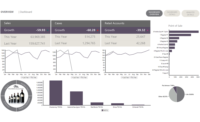The biggest threats to global supply chains in 2016 include cargo theft, weather disruptions, health crises, labor unrest and ISIS, according to BSI Group’s “2015 SCREEN Global Supply Chain Intelligence Report.”
That’s why many of today’s software providers created Internet of Things (IoT)-enabled, cloud-based solutions, designed to better manage complex supply chains in hopes of curtailing disruption and threats.
Great Bay Software, Minneapolis, for instance, released the Beacon Suite, which helps enterprises gain real-time visibility and control across all connected devices, including emerging IoT solutions. How it works is, it collects hundreds of key attributes from all connected devices and stores the data in the Warehouse of Context.
“We want them to not only know about everything on their network in real time, but also give them a chance to react to changes when our system believes the identity of a device has been altered in a meaningful way,” says Seth Jeacopello, chief architect and engineering manager.
Helping round out the Beacon Suite is the Beacon Endpoint Enforcement module, which simplifies and automates endpoint and IoT device authentication and onboarding as well as enforcement of access policies. The Beacon Enforcement module leverages Beacon’s behavior monitoring capabilities to alert, quarantine or block a device when an unusual behavior, such as MAC spoofing, is detected.
“We are pleased that we’ve been able to accelerate our development cycles to be able to help enterprises get ahead of IoT security threats brought on by devices with deficient onboard security,” says Jim Scullion, chief executive officer.
To better manage complex supply chains, JDA Software, Scottsdale, Ariz., introduced JDA Manufacturing Planning, which powers always-on synchronization and execution, in-memory workflows, prescriptive analytics and real-time collaboration.
“JDA Manufacturing Planning offers a seamless experience on a single platform, spanning diverse supply chain processes. These features enable manufacturers to achieve breakthrough levels of business performance by addressing challenges such as increased demand volatility, business velocity and intense competition, all of which have placed heightened pressures on supply chains to be responsive to disruptions and changes,” says Puneet Saxena, global vice president, solutions strategy and manufacturing planning. “As more and more supply chain data becomes available in real-time through IoT, we are at the threshold of unleashing the next wave of supply chain efficiencies across end-to-end value chains. Our adaptable manufacturing strategy incorporates Big Data and cloud-based, in-memory technologies, and allows companies to maximize return on invested capital.”
In 2016, Zebra Technologies focused on developing solutions that take advantage of a standards-based IoT to enable improved food safety. For instance, the Vernon Hills, Ill.-based company collaborated with Bosch Connected Devices and Solutions, Chicago, to offer a smart refrigeration solution for mobile supply chain scenarios, providing real-time intelligence and electronic records of integrity. The easy-to-deploy, cloud-based temperature monitoring solution uses wireless sensors, mesh networking, mobile computers and the Zatar IoT cloud service. It also utilizes Bosch’s cross domain development kit (XDK), which includes multiple sensors for monitoring various product conditions.
Zebra Technologies also partnered with Atmel Corp., San Jose, Calif., to release a smart refrigeration IoT solution that allows retailers, manufacturers and logistics providers to quickly deploy automatic, commercial-class temperature monitoring in stores and facilities from trusted vendors. The Smart Refrigeration IoT Solution Reference Design provides easy-to-deploy, cloud-based temperature monitoring using wireless sensors, mesh networking technologies and the Zatar IoT cloud service.
“Zebra is an innovator in IoT and cloud-based solutions for the supply chain, and we have been working with collaborators in the standards bodies,” says Adebayo Onigbanjo, director of new growth platforms marketing. “Zebra is investing in Big Data and is evaluating machine-learning analytics services for food safety customers as well as reviewing other supply chain-related use cases.”
Meanwhile, Progistix, Reno, Nev., launched Freightflow, what is said to be the next generation of cloud-based transportation management system. Designed specifically for the produce industry, Freightflow’s platform integrates ERP business software with transportation tools to provide complete supply chain visibility from a single platform.
“Freightflow improves collaboration within your team. Each team member has access to up-to-date, real-time information/status about every load on all their devices. Freightflow’s dynamic reporting puts sophisticated, comprehensive analysis at your fingertips,” says Bud Floyd, president. “Our goal is to focus on perishables, provide state-of-the-art tools to small and medium businesses to improve visibility, collaboration and the use of real-time information to affect and manage process improvements.”
For its part, Opto 22, Temecula, Calif., introduced the groov with Node-RED, an IoT solution that integrates automation systems, like automated packaging equipment, control refrigeration systems and manufacturing lines, with back-end IT or cloud-based systems. groov is a zero-programming, web-based way to build, deploy and view effective, scalable operator interfaces and system dashboards to monitor and control systems and equipment using mobile devices and other computer-based systems.
“Two of the biggest problems these new software solutions help solve are application design complexity and a shortage of qualified operations technology programmers,” says Matt Newton, director of technical marketing. “With the addition of open standards-based programming capabilities to industrial programmable automation controllers, we’ve reduced or even eliminated the need for complex middleware and protocol conversion in industrial applications. Open-standards programming also means organizations can tap into the massive pool of developer talent in the web application space and apply those talents and resources to traditional industrial automation problems and applications.”
Opto 22 also released Node-RED nodes for its industrial programmable automation controllers (PACs), designed to significantly decrease IIoT application development time and complexity. Node-RED is an innovative visual wiring tool that connects edge computing systems such as industrial automation controllers to cloud services such as Amazon Web Services (AWS) IoT, IBM Watson IoT and Microsoft Azure.
“These new software development solutions are targeted toward internet or web application developers,” adds Newton. “Our objective is to tap into the millions of JavaScript and web developers and try to focus their talents on the problems that the industrial markets are facing today. We’re trying to provide a path to bridge the gap between OT and IT disciplines to begin building IoT applications that really add value.”
Go to http://bit.ly/1L8ZurQ to learn more about these and other software solutions.











